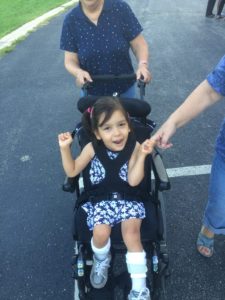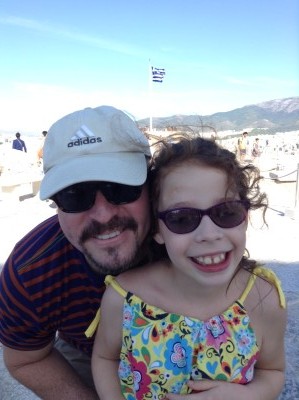Cute wheelchair costume! But who is it for?
A colleague’s husband wrote a column for the Chicago Tribune about navigating the city as a modern dad on his mundane weekend errands with two kids in tow. In his essay, Jeremy Manier took note of strangers approaching him during the trip and reacting to his parenting by exclaiming “What a Dad!”
It’s in these simple and regular events that fathers often get more praise than mothers because, perhaps, the bar is set low for men. Regardless, Manier dubs these simple acts of parenthood as “What a Dad!” or “W.A.D.” moments. Here’s an excerpt from Manier’s essay:
Be assured, mothers, this is not some self-satisfied father’s lame attempt to horn in on your Day. In fact, after the second time it happened, I started thinking the huzzahs aimed at me actually reflected badly on dads and our iffy history of child care.
If I’d been a mom, no one would have noticed me feeding my infant son with my preschool daughter at my side. That’s what mothers do, right? But being a man, I got credit just for showing up and not losing either kid in the electronics aisle.
Because my young Elena has a very visible disability, I would argue that my W.A.D. moments are even more pronounced than Manier’s. A trip to the grocery store to pick up milk, vegetables, and dinner? “What a Dad!” Flying a kite with my daughter? Total W.A.D. moment. Speaking to the parents in Elena’s class about her disability? W.A.D.
My proudest W.A.D. moments for the last few years have certainly been Elena’s Halloween costumes. I have to admit that I have truly been knocking it out of the park. I found her disability not only as a challenge to my creativity, but also as an opportunity to come up with something witty within the constraints of her mobility.
Elena wasn’t able to sit independently early on in her life, so her first year trick-or treating she came as a lobster in a pot. The next year she was a bag of money stolen from a bank. And last year? I converted her wheelchair into a construction vehicle. She came as a bulldozer.
Elena’s costume this year is inspired by one of her favorite movies, Ratatouille. Continuing my streak of Halloween excellence and creativity this year, I’ve converted her wheelchair to a full stove and oven. Elena will don a chef’s hat and apron while (hopefully) sitting comfortably behind a stove — I made that stove out of wood that fits over her wheelchair.
Elena premiered her costume a few weeks ago at the 2016 Easterseals DuPage and Fox Valley fashion show. The theme this year was Hollywood. After blogging about Elena for the last year, she’s kind of turned into a local celebrity (well, at least in my mind) and we were given a table right next to the runway.
Elena rolled down the runway with her three cousins, two who dressed as servers and one who joined Elena dressed as a chef. Her cousins smiled and waved as they slowly walked down the runway, but I couldn’t help but notice a slight grimace and hint of discomfort on Elena’s face. Clearly, she was uncomfortable in her chair. She was not enjoying the spotlight as much as I thought she might.
The Easterseals fashion show is wildly successful and celebrates children of all abilities, but I wondered. How much was Elena herself enjoying the event? Days before the event she had been experiencing what we call “bad body days” — times when her body just doesn’t listen to her and ultimately causes her pain or discomfort. Was it that? Or was it that maybe, just maybe, she just didn’t want to be a chef for Halloween? I’m not really sure.
What I did realize, however, is that I never asked Elena what she wanted to be for Halloween. Is it an awesome costume? Yes. But for whom? For Elena? Or for me?
I had completely neglected Elena’s opinions and voice. It was then that I realized that my W.A.D. moments were perhaps for myself and not for my daughter.
We tried on the costume last night and she seemed to be happy, so right now it gets the green light for this year’s Halloween. But if she wakes up on trick-or-treat day and decides to be Elsa from Frozen, one of my goofy costumes, or even the eponymous Princess Elena of Avalor, that’s fine, too. Regardless of the choice, I want it to be hers. What a kid!
















